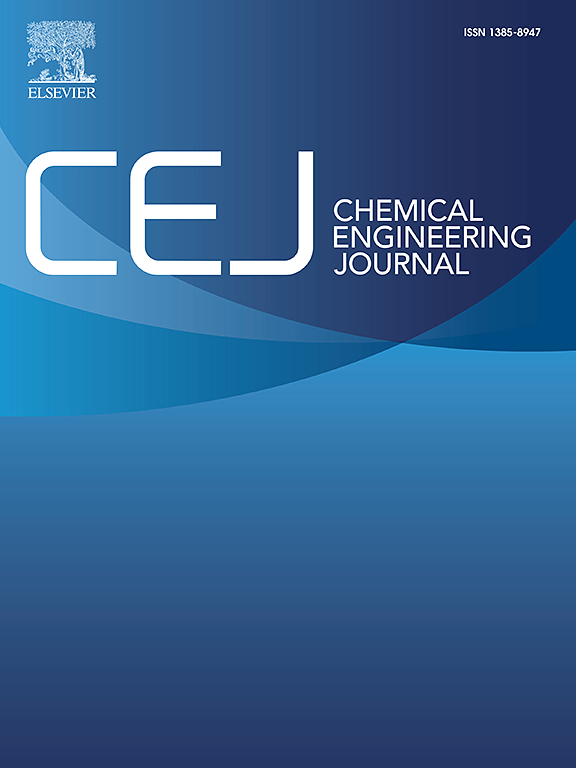可扩展,坚固耐用的石墨烯oxide@liquid晶体弹性体纤维驱动器,具有三维复杂光热驱动,用于软机器人和智能纺织品
IF 13.2
1区 工程技术
Q1 ENGINEERING, CHEMICAL
引用次数: 0
摘要
光响应液晶弹性体(LCE)纤维由于其灵活性和可控性,在软机器人和智能设备的开发中具有相当大的前景。然而,大多数具有光热效应的无机材料与液晶弹性体基体不相容,这可能导致无机材料与有机液晶体系之间的界面结合不稳定。同时,液晶弹性体纤维的多维空间变形仍然是一个挑战。本研究采用多种可聚合氧化石墨烯(GO)单体作为光铝热剂,通过干纺丝和两步交联法制备了具有稳定有机-无机界面键合的GO@LCE纤维致动器。由于界面之间的共价键作用,致动器具有出色的光热转换能力,并且具有优异的断裂强度、可重复使用性和工作能力(400.7 kJ m−3)。作为概念验证,成功构建了基于GO@LCE纤维作动器一维线性运动的光控人工肌肉和微型爬行器。重要的是,GO@LCE针织面料,能够在不同程度和形式的三维弯曲变形,巧妙地编织通过针织结构的设计。这项工作可以为软机器人和智能纺织品的发展提供新的可能性。本文章由计算机程序翻译,如有差异,请以英文原文为准。

Scalable, robust and durable graphene oxide@liquid crystal elastomer fiber actuator with three-dimensional complex photothermal actuation for soft robotics and smart textiles
Light-responsive liquid crystal elastomer (LCE) fibers hold considerable promise for use in the development of soft robotics and smart devices due to their flexibility and controllability. However, most of the inorganic materials with photothermal effects are incompatible with the liquid crystal elastomer matrix, which can result in unstable interfacial bonding between the inorganic materials and the organic liquid crystal system. Meanwhile, the multidimensional space deformation of liquid crystal elastomer fibers remains challenging. Here, numerous polymerizable graphene oxide (GO) monomers are employed as a photothermite, and the GO@LCE fiber actuators with stable organic-inorganic interfacial bonding are constructed by dry spinning and two-step crosslinking method. The actuators demonstrate remarkable photothermal conversion capability, and they also exhibit exceptional breaking strength, reusability and work capacity (400.7 kJ m−3), benefiting from the covalent bonding between the interfaces. As a proof-of-concept, light-controlled artificial muscle and micro crawler based on the one-dimensional linear motion of GO@LCE fiber actuators are successfully constructed. Importantly, GO@LCE knitted fabrics, which are capable of three-dimensional bending deformations in different degrees and forms, are skillfully woven through the design of knitted structures. This work can enhance new possibilities for the advancement of soft robotics and smart textiles.
求助全文
通过发布文献求助,成功后即可免费获取论文全文。
去求助
来源期刊

Chemical Engineering Journal
工程技术-工程:化工
CiteScore
21.70
自引率
9.30%
发文量
6781
审稿时长
2.4 months
期刊介绍:
The Chemical Engineering Journal is an international research journal that invites contributions of original and novel fundamental research. It aims to provide an international platform for presenting original fundamental research, interpretative reviews, and discussions on new developments in chemical engineering. The journal welcomes papers that describe novel theory and its practical application, as well as those that demonstrate the transfer of techniques from other disciplines. It also welcomes reports on carefully conducted experimental work that is soundly interpreted. The main focus of the journal is on original and rigorous research results that have broad significance. The Catalysis section within the Chemical Engineering Journal focuses specifically on Experimental and Theoretical studies in the fields of heterogeneous catalysis, molecular catalysis, and biocatalysis. These studies have industrial impact on various sectors such as chemicals, energy, materials, foods, healthcare, and environmental protection.
 求助内容:
求助内容: 应助结果提醒方式:
应助结果提醒方式:


